Bb12.9
 |
 |
 |
 |
|
Bb12-1 (427
+ 35) |
Bb12-2 (463) |
Bb12-3 |
Bb12-4 (465) |
|
Nov 3 |
4 |
5 |
6 (310) |
|
ω Bootis (227.2),
NEKKAR (Herdsman) = β Bootis
(227.3), σ Librae (227.5), π² Oct. (227.7),
NADLAT (Mean Little Ones) = ψ Bootis
(227.8), π Lupi (227.9)
*227 - *35 = *192 (MIMOSA) |
15h (228.3)
ZUBEN HAKRABIM (Claw of the Scorpion) = ν Librae
(228.3), λ Lupi (228.9) |
ω
Oct. (229.3),
ι
Librae (229.6),
κ
Lupi (229.7),
ζ
Lupi (229.8) |
Al
Zubānā-14b (Claws)
χ
Bootis (230.3),
PRINCEPS =
δ
Bootis
(230.6),
ZUBEN ELSCHEMALI (Northern Claw) =
β
Librae
(230.8) |
|
May 4 |
5 (125) |
6 |
7 (127 = 310
- 183) |
|
'April 7 |
8 |
9 |
10 (100) |
|
"March 24 |
25 (Julian equinox) |
26 (*5) |
27 (86 = 127
- 41) |
|
MARCH 1 |
2 (61 = 125 -
64) |
3 |
4 |
|
MENKAR (The Nose) =
α
Ceti
(44.7)
*44 - *35 = *9 (DENEB KAITOS) |
3h (45.7)
GORGONEA TERTIA =
ρ
Persei
(45.1),
ALGOL (The Demon) =
β
Persei
(45.9) |
ι
Persei (46.1),
MISAM (Next to the Pleiades) =
κ
Persei
(46.2),
GORGONEA QUARTA =
ω
Persei
(46.7),
BOTEIN (Pair of Bellies) =
δ
Arietis
(46.9) |
ζ Arietis (47.7) |
|
eaha
te ika hiku raverave |
e
tagata
hakapuo - i te haú |
i
ruga i te ragi |
eaha
te manu itiiti |
|
Hiku. Tail; caudal fin.
Hikukio'e, 'rat's tail': a plant (Cyperus
vegetus). Vanaga.

... In China,
with Capricornus, Pisces, and a part of
Sagittarius, it [Aquarius] constituted the early
Serpent, or Turtle, Tien Yuen; and later
was known as Hiuen Ying, the Dark Warrior
and Hero, or Darkly Flourishing One, the
Hiuen Wu, or Hiuen Heaou, of
the Han dynasty, which Dupuis
gave as Hiven Mao. It was a symbol of the
emperor Tchoun Hin, in whose reign was a
great deluge; but after the Jesuits came in it
became Paou Ping, the Precious Vase. It
contained three of the sieu, and headed the list
of zodiac signs as the Rat, which in the
far East was the ideograph for 'water', and
still so remains in the almanacs of Central
Asia, Cochin China, and Japan ...
...
In the deep night before the
image [of Lono] is first seen, there is a
Makahiki ceremony called
'splashing-water' (hi'uwai). Kepelino
tells of sacred chiefs being carried to the
water where the people in their finery are
bathing; in the excitement created by the beauty
of their attire, 'one person was attracted to
another, and the result', says this convert to
Catholicism, 'was by no means good' ...
 |
*20 |
 |
*16 |
 |
|
Bb11-9 (427) |
Bb11-29 |
Bb12-2 (463 = 427 + 36) |
|
MIMOSA (*192) |
THUBAN (*212) |
ZUBEN HAKRABIM (*228) |
|
DENEB KAITOS (*9) |
ALRISHA (*29) |
ALGOL (*45 = *9 + *36) |
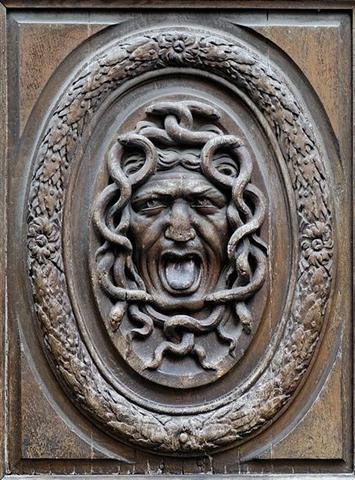
...
In the sky, Perseus lies next to his
beloved Andromeda. Nearby are her
parents Cepheus and Cassiopeia, as well
as the monster, Cetus, to which she was
sacrificed. Pegasus the winged horse
completes the tableau. Perseus himself
is shown holding the Gorgon’s head. The
star that Ptolemy called ‘the bright one
in the Gorgon head’ is Beta Persei,
named Algol from the Arabic
ra’s al-ghul
meaning ‘the demon’s head’. (As an
aside,
al-ghul is
also the origin of our word alcohol -
quite literally ‘the demon drink’.)
Algol is the type of star known as
an eclipsing binary, consisting of two
close stars that orbit each other, in
this case every 2.9 days ...
|
5 days after Algol (*45) was Algenib Persei
(*50) and 10 days after Algol were the
6 Stars (Tau-ono *55):
 |
 |
 |
|
Bb12-5 (421 + 466) |
Bb12-6
(888) |
Bb12-7 |
|
Nov 7
(311) |
8 |
9 |
|
μ
Lupi,
γ
Tr. Austr.
(231.3), ο Librae (231.8) |
ο
Cor. Borealis (232.0),
δ
Lupi (232.1),
φ¹,
ν²
Lupi (232.2),
ν¹
Lupi (232.3),
ε
Lupi (232.4),
φ²
Lupi (232.5),
PHERKAD (The Dim One of the Two Calves) =
γ
Ursae Min.
(232.6),
ε
Librae (232.7),
η
Cor. Borealis (232.8),
υ
Lupi (232.9)
*191.0 = *232.4 - 41.4 |
ALKALUROPS (The Herdsman's Lance) =
μ
Bootis
(233.1),
ED ASICH (Male Hyena) =
ι
Draconis
(233.2) |
|
ZIBAL (Young Ostriches) = ζ Eridani (48.0),
κ
Ceti (48.9) |
τ Arietis (49.7) |
ALGENIB PERSEI = α Persei (50.0),
ο Tauri (50.2), ξ Tauri (50.8)
GIENAH (γ Corvi) |
|
May 8
(128) |
9 |
10 |
|
'April 11 (101) |
12 |
13 |
|
ui ki te mata mai tae e haga
hia |
ka tupu te kihikihi |
ma to ihe |
|
Kihikihi, lichen;
also: grey, greenish grey, ashen. Vanaga.
Kihikihi, lichen T, stone T. Churchill.
The Hawaiian day was
divided in three general parts, like that of
the early Greeks and Latins, - morning,
noon, and afternoon - Kakahi-aka,
breaking the shadows, scil. of night;
Awakea, for Ao-akea, the plain
full day; and Auina-la, the decline
of the day. The
lapse of the night, however, was noted by
five stations, if I may say so, and four
intervals of time, viz.: (1.) Kihi,
at 6 P.M., or about sunset; (2.) Pili,
between sunset and midnight; (3) Kau,
indicating midnight; (4.) Pilipuka,
between midnight and surise, or about 3
A.M.; (5.) Kihipuka, corresponding to
sunrise, or about 6 A.M. ... (Fornander)
 |
 |
 |
 |
 |
 |
|
Bb12-8 |
Bb12-9 |
Bb12-10 |
Bb12-11 |
Bb12-12 (473) |
|
Nov
10 (314 → π) |
11 |
12 |
13 |
14 |
|
NUSAKAN (Pauper's Bowl) = β Cor. Bor.
(234.0), κ¹ Apodis (234.3), ν Bootis
(234.7), ζ Librae (234.9) |
θ Cor. Borealis (235.3), γ Lupi (235.6),
GEMMA = α Cor. Bor.,
ZUBEN ELAKRAB = γ Librae, QIN = δ
Serpentis, ε Tr. Austr.
(235.7), μ Cor. Borealis (235.8), υ
Librae (235.9)
SIRRAH (α Andromedae) |
φ Bootis (236.2), ω Lupi, τ Librae
(236.3), ψ¹ Lupi (236.7), ζ Cor.
Borealis (236.9) |
.
κ
Librae (237.2),
ι
Serpentis (237.4),
ψ²
Lupi,
ρ
Oct.
(237.5), γ Cor. Borealis, η Librae
(237.7), COR
SERPENTIS = α Serpentis
(237.9)
*196.0 = *237.4 - *41.4 |
π
Cor. Borealis,
UNUK ELHAIA (Necks of the Serpents) =
λ
Serpentis
(238.1),
CHOW =
β
Serpentis
(238.6) |
|
... In other words, the ancient Druidic
religion based on the oak-cult will be
swept away by Christianity and the door
- the god Llyr - will languish forgotten
in the Castle of Arianrhod, the
Corona Borealis. This helps us to
understand the relationship at Rome of
Janus and the White Goddess Cardea who
is ... the Goddess of Hinges who came to
Rome from Alba Longa. She was the hinge
on which the year swung - the ancient
Latin, not the Etruscan year - and her
importance as such is recorded in the
Latin adjective cardinalis - as
we say in English 'of cardinal
importance - which was also applied to
the four main winds; for winds were
considered as under the sole direction
of the Great Goddess until Classical
times ... |
|
σ Persei (51.6) |
No star listed (52) |
ψ
Persei (53.1)
ACRUX (α
CRUCIS) |
δ
Persei (54.7) |
Al Thurayya-27
(Many Little Ones) /
Krittikā-3 (Nurses of Kārttikeya)
/
TAU-ONO (Six
Stones)
ATIKS =
ο
Persei,
RANA (Frog) = δ Eridani
(55.1),
CELAENO (16 Tauri), ELECTRA (17),
TAYGETA (19),
ν
Persei (55.3), MAIA (20), ASTEROPE (21),
MEROPE (23)
(55.6)
|
 |
|
May 11 |
12
(132 = 105 + 27) |
13 |
14 |
15
(365 + 135 = 500) |
|
'April 14 (104) |
15 |
16
(*26) |
17
(107) |
18
(108) |
|
e tagata rima piri ki
te puoko |
ko te maitaki |
i haga opua
hia |
ko te tagata kua oho
- ki haga o rave
hía |
mai tae rutu
hia i te
pahu - mai tae oho te rima |
|
Rutu.
1. To read, to recite, to pronounce
words solemnly; he-rutu i te kohau
motu, to read the rongorongo
tablets; hare rutu rogorogo mo
hakama'a ki te ga poki ite kai, i te
rogorogo, rongorongo school, house
in which children were taught reading
and writing the rongorongo signs. 2. To
pelt with stones. 3. To gather in great
numbers (of people). Vanaga. Sound.
Rutu-rongorongo = the sound of
recitation. Barthel. T. Beat. Henry. To
recite; tae rutu, irreverence.
Churchill.Pau.: rutu, a drum.
Mgv.: rutu, to beat, to cause to
resound. Ta.: rutu, a drum, to
drum. Mq.: utu, to drum. Sa.:
lutu, to shake a rattle.
Churchill.
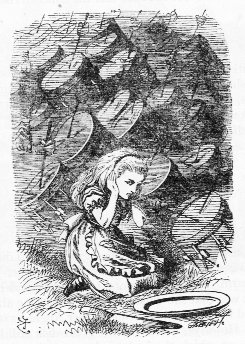
... rutua - te pahu -
rutua te maeva - atua rerorero - atua
hiko ura - hiko o tea - ka higa te ao ko
te henua ra ma te hoi atua ... (Cb1)
Pahu.
Drum. Pahu-rutu-roa =
Long-beating-drum. Barthel. M. Pahū.
Tree gong. Starzecka.
Pahu uma,
coffin; in modern usage, any sort of
jar. Pahupahu = To dig a hole.
Vanaga. A trough, barrel, cask, cradle,
drum, chest, box;
pahu nui,
a kettle;
pahu oka,
a drawer;
pahu papaku,
coffin;
pahu rikiriki, sheath;
pahu
viriviri, hogshead.
Pahupahu,
box. Churchill. A trough, barrel, cask,
cradle, drum, chest, box;
pahu nui,
a kettle;
pahu oka, a drawer;
pahu
papaku, coffin;
pahu
rikiriki, sheath;
pahu
viriviri, hogshead;
pahupahu,
box. P Mgv., Ta.:
pahu,
a drum. Mq.:
pahu,
a drum, a large cylindrical container.
(To.:
bahu, a hollow tree set in
water as a filter.) Sa.:
pusa,
a box. To.:
buha, id. Fu.:
pusa,
id. Niue:
puha, id. Pau.:
puha,
id.
Pahuahi, lantern, beacon.
Paukumi,
closet, cupboard.
Pahupopo,
a mould;
pahupopokai, cupboard for
food.
Pahure: 1. To sweep
everything away. 2. To wound, to
lacerate, scar, bruise, lesion, sore;
pahurehure, to wound, to
scratch;
hakapahure, to wound. T
Pau.:
pahure, to be skinned;
pahore,
to peel off, to scale. Mgv.:
pahore,
to cut off, to chop, to slice. Ta.:
pahore,
to flay, to skin. Churchill 2.
|
 |
 |
 |
 |
 |
 |
 |
 |
|
Bb12-13 |
Bb12-14 |
Bb12-15 |
(477 = 300 + 177) |
Bb12-17 |
Bb12-18 |
(300 + 180) |
Bb12-20 |
|
Nov 15 |
16 (320) |
17 |
18 (*242) |
19 |
20 |
21 (*245) |
22 (326) |
|
... The correspondence between the
winter solstice and the kali'i
rite of the Makahiki is
arrived at as follows: ideally, the
second ceremony of 'breaking the
coconut', when the priests assemble
at the temple to spot the rising of
the Pleiades, coincides with the
full moon (Hua tapu) of the
twelfth lunar month (Welehu). In
the latter eighteenth century, the
Pleiades appear at sunset on 18
November. Ten days later (28
November), the Lono effigy
sets off on its circuit, which lasts
twenty-three days, thus bringing the
god back for the climactic battle
with the king on 21 December, the
solstice (= Hawaiian 16 Makali'i). The
correspondence is 'ideal' and only
rarely achieved, since it depends on
the coincidence of the full moon and
the crepuscular rising of the
Pleiades ... |
|
κ
Serpentis (239.3),
δ
Cor. Borealis,
TIĀNRŪ =
μ
Serpentis
(239.5),
χ
Lupi, (239.6),
ω
Serpentis (239.7),
BA (= Pa) =
ε
Serpentis,
χ
Herculis (239.8).
κ
Cor.
Borealis, ρ Serpentis (239.9) |
λ
Librae (240.0),
β
Tr. Austr. (240.3),
κ
Tr. Austr. (240.4),
ρ
Scorpii (240.8)
*199.0 = *240.4 - *41.4 |
Iklīl
al Jabhah-15 (Crown of the Forehead)
/
Anuradha-17
(Following Rādhā)
/
Room-4 (Hare)
ξ
Lupi,
λ Cor.
Bor.(241.1),
ZHENG =
γ
Serpentis,
θ
Librae (241.2),
VRISCHIKA =
π
Scorpii
(241.3),
ε
Cor.
Borealis (241.5),
DSCHUBBA
(Front of Forehead) = δ Scorpii
(241.7), η Lupi (241.9) |
υ
Herculis (242.3),
ρ Cor. Borealis (242.4),
ι
Cor. Borealis (242.5),
θ
Draconis (242.6),
ξ
Scorpii (242.7)
SCHEDIR (Breast) α Cassiopeiae
*201.0 = *242.4 - *41.4 |
16h (243.5)
ACRAB (Scorpion) = β Scorpii,
JABHAT AL ACRAB (Forehead of the
Scorpion) = ω Scorpii
(243.3), θ Lupi,
RUTILICUS = β Herculis
(243.5),
MARFIK (Elbow) = κ Herculis
(243.7), φ Herculis (243.8) |
ψ
Scorpii (244.6),
LESATH (Sting) =
ν
Scorpii
(244.8) |
χ
Scorpii (245.1),
YED PRIOR (Hand in Front) =
δ
Ophiuchi,
δ
Tr.
Austr. (245.5) |
YED POSTERIOR (Hand Behind) =
ε
Ophiuchi,
RUKBALGETHI SHEMALI (Northern Knee
of the Giant) =
τ
Herculis
(246.6).
δ
Apodis (246.7),
ο
Scorpii (246.8) |
|
May 16 |
17 |
18 (111 + 27) |
19 (*59) |
20 (140) |
(111 + 30) |
22 |
23 (*63) |
|
Hairy Head-18
(Cockerel) /
Temennu-3
(Foundation Stone)
ALCYONE
(56.1),
PLEIONE (28 Tauri), ATLAS (27 Tauri)
(56.3) |
MENKHIB (Next to the Pleiades =
ζ
Persei
(57.6)
PORRIMA (γ Virginis) |
ZAURAK (Boat) = γ Eridani
(58.9) |
λ Tauri (59.3), ν Tauri (59.9) |
4h (60.9)
JĪSHUĬ = λ Persei
(60.7)
COR CAROLI (α Canum Ven.) |
υ Persei (61.2) |
BEID (Egg) =
ο¹
Eridani
(62.2),
μ
Persei (62.8)
VINDEMIATRIX ( ε Virginis) |
Al Dabarān-2 (The Follower)
HYADUM I =
γ
Tauri (63.4)
*22.0 = *63.4 - *41.4 |
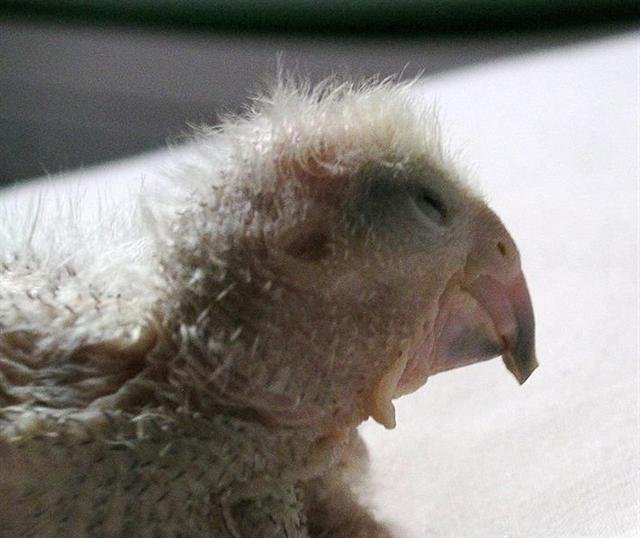
... Long ago in the very beginning
of time there dwelt within a shell
an infant god whose name was
Ta'aroa. He was Ta'aroa
the unique one, the ancestor of all
gods, the creator of the universe
whose natures were myriad, whose
backbone was the ridgepole of the
world, whose ribs were its
supporters. The shell was called
Rumia, Upset. Becoming aware at
last of his own existence and
oppressed by a yearning loneliness
Ta'aroa broke open his shell
and, looking out, beheld the black
limitless expanse of empty space.
Hopefully, he shouted, but no voice
answered him. He was alone in the
vast cosmos. Within the broken
Rumia he grew a new shell [cfr
Bb8-27] to
shut out the primeval void
... |
|
'April 19 |
20 |
21 (111) |
22 (*32) |
23 |
24 |
(325 - 210) |
26 (*36) |
|
"April 5 (95) |
6 |
7 |
8 |
9 |
10 (100) |
11 (*21) |
(*63 - *41) |
|
MARCH 13 |
14 (73) |
15 |
16 (139 - 64 = 75) |
17 |
18 |
19 (78) |
20 (*364) |
|
ki to ihe |
ka hakatu i
te ariki |
ko te ika
hagai mai o te ariki - ka rere te
manu |
mai tae haú hia (Barthel's note;
durchgestricken: ua) |
ka rere koe
- ki te
toga tu |
e rima |
haú
hia |
mai tae
rutu hia
te pahu - e rima
|
 |
 |
 |
 |
 |
 |
 |
|
Bb12-21 |
Bb12-22 |
Bb12-23 |
Bb12-24 (485) |
Bb12-25 |
122 *
6 = 2 * 366 |
Bb12-27 |
|
Nov 23 |
24 |
25 (329) |
26 |
27 |
28 (332) |
29 |
|
SEPT 20 |
21 (264) |
22 (*185) |
23 |
24 |
25 (*188) |
26 |
|
Heart-5
(Fox)
σ
Scorpii
(247.0),
HEJIAN =
γ
Herculis
(247.2),
ψ
Ophiuchi (247.7) |
ρ
Ophiuchi (248.1),
KAJAM (Club) =
ω
Herculis
(248.3),
χ
Ophiuchi (248.5),
SHE LOW (Market Tower) =
υ
Ophiuchi,
Tr.
Austr. (248.7), ζ Tr. Austr.
(248.8) |
Al Kalb-16 (The Heart)
/
Jyeshtha-18 (Eldest)
/
ANA-MUA-1
(Entrance pillar)
ANTARES = α Scorpii
(249.1),
MARFIK (Elbow) = λ Ophiuchi,
φ Ophiuchi (249.5), ω Ophiuchi
(249.8) |
γ Apodis
(250.1), σ Herculis (250.3), θ
Tr. Austr. (250.6), τ Scorpii
(250.7) |
HAN = ζ Ophiuchi
(251.0) |
ζ
Herculis,
η
Tr. Austr.
(252.1), η Herculis,
β Apodis
(252.5) |
ATRIA = α Tr. Austr.
(253.9) |
|
... In
Bayer's Uranometria from
the year 1603 the Bird of
Paradise is depicted among the
constellations in the southern
sky. The name Apus means
'without feet'. The great
paradise birds of East India
have exceedingly beautiful
feathers but very ugly feet.
When anciently the natives tried
to sell these birds to the
Europeans they therefore first
cut off their feet ...
.jpg) |
|
May 24 (*64) |
25 (145) |
26 |
27 |
28 (148) |
29 |
30 |
|
HYADUM II = δ¹ Tauri
(64.2) |
Net-19 (Crow)
AIN (Eye) =
ε
Tauri,
θ¹
Tauri,
θ²
Tauri (65.7)
|
No star listed (66) |
No star listed (67) |
Rohini-4 (The Red One)
/
Pidnu-sha-Shame-4 (Furrow of
Heaven)
/
ANA-MURI-2 (Rear pillar - at the
foot of which was the place for
tattooing)
ALDEBARAN = α Tauri
(68.2),
THEEMIN = υ² Eridani
(68.5) |
No star listed (69) |
No star listed (70) |
|
'April 27 |
28 (118) |
29 |
30 |
'May
1 (121) |
2 |
3 |
|
"April 13 |
14 (104) |
15 |
16 |
17 (107) |
18 |
19 |
|
MARCH 21 |
22 (81) |
23 |
24 |
25 (84) |
26 |
27 |
|
ki te
tagata -
hahaú i to maro |
ka rere
te manu -
hahaú i te maro |
erua
hokohuki mau a ana |
ma te
kava haga i ruga ia ia |
ka tupu
te pua |
e
tagata vae oho |
ki te
rima - rave ika |
|
... To blow
freshly, coolness, zephyr,
salubrious, breeze, wind (hahau,
ahau) ...
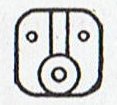
Ta.: Maro,
dry, desiccated. Mq.:
mao,
thirst, desiccated. Fu.:
malo,
dry. Ha.: malo,
maloo,
id. Churchill.
Va'e:
Foot, leg; te va'e mata'u, te
va'e maúi, right foot, left
foot. Va'e ruga, va'e raro,
quick and light, without detour
(lit.: foot up, foot down).
Ka-oho koe ki a nua era va'e
ruga va'e raro, ina ekó
hipa-hipa, hurry straight to
your mother, do not make any
detours. Va'e pau,
misshapen foot, clubfoot. Vae,
to choose. Vaega, middle,
centre; i vaega o, in the
middle of. Vanaga. 1. Foot, paw,
leg, limb; vae no roto,
drawers; karikari vae,
ankle. P Pau.: vaevae,
foot, leg. Mgv.: vaevae,
id. Mq.: vae, id. Ta.:
vaevae, avae, id. 2.
Pupil. 3. To choose, elect,
prefer, promote, vote; vavae,
to destine, to choose; vaea
(vae 2), pupil.
Vaeahatu (vae 1 -
ahatu): moe vaeahatu,
to sleep sprawling with legs
extended. Vaega, center,
middle, within, half; o vaega,
younger; ki vaega, among,
between, intermediate. P Pau.:
vaega, the middle. Mgv.:
vaega, center, middle.
Mq.: vaena, vavena,
vaveha, id. Ta.:
vaehaa, half. Vaehakaroa
(vae 1 - roa):
moe vaehakaroa, to sleep
with legs stretched out.
Vaehau (vae 1 -
hau 3), pantaloons,
trousers. Vaeherehere (vae
1 - here 1), to attach by
the paw. Vaerere (vae
1 - rere 1), to run.
Churchill. Ta.: 1. Timbers of a
boat. Ha.: wae, knees,
side timbers of a boat. 2. To
share out. Sa.: vae, to
divide, to share. Ma.: wawae,
to divide. Churchill.
Oho. 1. To go:
ka-oho! go! go away! (i.e.
'goodbye' said by the person
staying behind); ka-oho-mai
(very often contracted to:
koho-mai), welcome!
(lit.: come here); ku-oho-á
te tagata, the man has gone.
Ohoga, travel, direction
of a journey; ohoga-mai,
return. 2. Also rauoho,
hair. Vanaga. 1. To delegate;
rava oho, to root. 2. To go,
to keep on going, to walk, to
depart, to retire; ka oho,
begone, good-bye; oho amua,
to preced; oho mai, to
come, to bring; oho arurua,
to sail as consorts; hakaoho,
to send, a messenger. 3. Tehe
oho te ikapotu, to abut,
adjoin; mei nei tehe i oho
mai ai inei te ikapotu, as
far as, to; kai oho, to
abstain, to forego; hakaoho,
to put on the brakes. 4. The
head (only in the composite
rauoho, hair). Churchill.
 |
 |
 |
|
Bb12-24 |
Bb12-25 |
Bb12-26 |
|
MARCH 24 |
JULIAN
EQUINOX |
26 (85) |
 |
 |
 |
|
haati |
mauga |
vae |
 |
 |
*8 |
 |
 |
|
COR
SERPENTIS
(*237) |
TAU-ONO
(*55) |
YED
PRIOR
(*245) |
HYADUM I
(*63) |
|
*3 |
 |
 |
 |
 |
|
ANTARES
(*249) |
Nov
26
(330) |
ALDEBARAN
(*68) |
May
29
(149) |
|
... During his descent the ancestor still
possessed the quality of a water spirit, and his body, though
preserving its human appearance, owing to its being that of a
regenerated man, was equipped with four flexible limbs like
serpents after the pattern of the arms of the Great Nummo
[= Nommo, the 4th Dogon station
as counted from zero at the satellite of Emma Ya, cfr F
respectively D below].

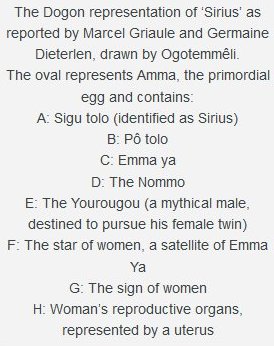
The ground was rapidly approaching. The
ancestor was still standing, his arms in front of him and the
hammer and anvil hanging across his limbs. The shock of his
final impact on the earth when he came to the end of the
rainbow, scattered in a cloud of dust the animals, vegetables
and men disposed on the steps. When calm was
restored, the smith was still on the roof, standing erect facing
towards the north, his tools still in the same position. But in
the shock of landing the hammer and the anvil had broken his
arms and legs at the level of elbows and knees, which he did not
have before. He thus acquired the joints proper to the new human
form, which was to spread over the earth and to devote itself to
toil ...
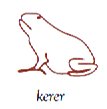
 |
 |
 |
 |
|
Bb12-28 (910) |
Bb12-29 (490) |
Bb12-30 |
Bb12-31 → Dec 31 |
|
Nov 30 (151 +
183) |
Dec 1 |
2 (336
→
4 * 84) |
3 |
|
SEPT 27 (270) |
28 (*191 →
Porrima) |
29 |
30 |
|
Tail-6 (Tiger)
WEI (Tail) = ε Scorpii,
η Arae (254.3),
DENEBAKRAB = μ Scorpii
(254.7) |
ι Ophiuchi (255.3),
GRAFIAS = ζ Scorpii (255.4)
*214.0 = *255.4 - *41.4 |
κ Ophiuchi (256.2), ζ Arae (256.5), ε Arae (256.8),
CUJAM (Club) = ε Herculi
(256.9) |
No star listed (257) |
|
May 31 (151) |
June 1 |
2 (336 - 183) |
June 3
(154)
→ 63 |
|
TABIT =
π³
Orionis
(71.7),
π²
Orionis (71.9) |
π4
Orionis (72.1),
ο¹
Orionis (72.4),
π5
Orionis (72.8)
*31.0 = *72.4 - *41.4 |
π¹
Orionis (73.0),
ο²
Orionis (73.4),
HASSALEH =
ι
Aurigae
(73.6),
π6
Orionis (73.9)
*32.0 = *73.4 - *41.4 |
ALMAAZ (The Male Goat) =
ε
Aurigae
(74.7),
HAEDUS I = ζ Aurigae
(74.8) |
 |
|
'May 4 (124 = 151 - 27) |
5 → 5 * 5 * 5 |
6 |
7 (127) |
|
"April 20 (151 -
41) |
21 (111 = 125 -
14) |
22 |
23 |
|
MARCH 28 |
29 (88 = 111 -
23) |
30 |
31 (90 = 154 -
64) |
|
kua noho ko te honu |
i te henua - kua haga i te maro |
ko te kave e kava tu - ki te maro |
kua hahe koia |
Reassuringly the Foot of Orion (Rigel *78) came 10 days
after Aldebaran (*68):
 |
 |
 |
 |
 |
|
Bb12-32 (914 → 364) |
Bb12-33 (5 * 183) |
Bb12-34 |
Bb12-35 |
Bb12-36 |
|
Dec 4 |
5 |
6 (340) |
7 |
8 |
|
OCT 1 (914 - 640) |
2 (275) |
3 |
4 |
5 (278) |
|
17h
(*258.7)
ARRAKIS = μ Draconis
(258.7) |
Mula-19 (The Root)
SABIK (The Preceding One) = η Ophiuchi
(259.7),
η
Scorpii (259.9) |
NODUS I =
ζ
Draconis
(260.0),
π
Herculis (260.7),
RAS
ALGETHI = α Herculis
(260.8) |
SARIN =
δ
Herculis
(261.0),
ο
Ophiuchi (261.4)
*220.0 = *261.4 - *41.4
ALRISHA (α Piscium) |
ξ Ophiuchi (262.2),
θ Ophiuchi, ν Serpentis, ζ, ι Apodis (262.4),
ι Arae (262.8), ρ Herculis (262.9)
*221.0 = *262.4 - *41.4 |
|
June 4 (155) |
5 |
6 |
7 |
8 |
|
HAEDUS II = η Aurigae
(75.9) |
5h (*76.1)
ε
Leporis (76.0),
CURSA (Footstool) =
β
Eridani (76.4),
λ
Eridani (76.7)
*35.0 = *76.4 - *41.4 |
μ Aurigae, μ Leporis (77.6) |
ĸ Leporis (78.0),
RIGEL (Foot) =
β
Orionis
(78.1),
Flaming Star = IC405
(78.2),
CAPELLA =
α
Aurigae (78.4),
ο
Columbae,
τ
Orionis (78.8)
*37.0 = *78.4 - *41.4
THUBAN (α Draconis) |
λ Aurigae (79.0), λ Leporis (79.6), ρ Aurigae (79.7)
ARCTURUS (α Bootis) |
 |
|
'May 8 (128) |
9 |
10 |
11 |
12 (132) |
|
"April 24 (114) |
25 (*35) |
26 |
27 |
28 (4 * 29½) |
|
APRIL 1 (91) |
2 |
3 |
4 |
5 |
|
ko te manu - mau i te poporo |
kua tupu ko te maga |
manu - mau i te poporo |
ma te maitaki - kua haga i te
maro |
koia ra - kua tupu i te maro |
|
Maga. Branch (of tree).
Magahaiga, part of the arm near the armpit,
armpit. Magamaga: 1. Finger (rima matu'a
neanea, thumb; tuhi henua, index finger;
roaroa tahaga, middle finger; tuhia háûa,
ring finger; komaniri-komanara, little
finger). 2. Seaweed (shaped like small fingers).
Vanaga. 1. (mama 2) A mouthful; maga
nuinui, to gobble. 2. Garbage. 3. Index finger.
4. A branch; magamiro, a branch, a limb;
magamaga, fork, finger, claw, rod; magamaga
miro, a branch, a limb; magamaga rima,
finger; magamaga vae, toe; magamaga tumu,
great toe; hakamaga, a roof; magaga,
fork; magatuhi, index finger; hakamagaturu,
slope of a roof. Churchill. |
A branch (Maga) is the opposite of a root (Mula),
and the Preceding One (Sabik) should be the opposite of
the Following One (Al Dabaran, Aldebaran). Sabik
(*259) - Aldebaran (*68) = *191 →
Porrima.
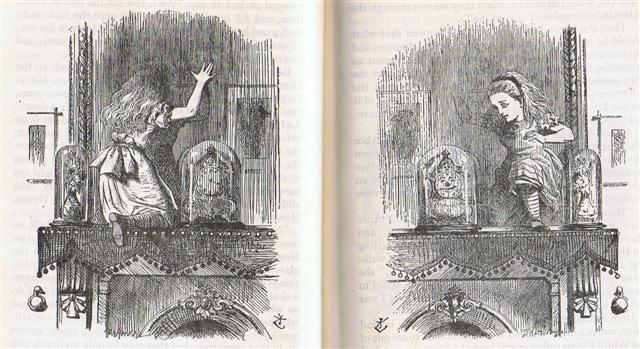
 |
 |
 |
 |
|
Bb12-37 |
Bb12-38 (920) |
Bb12-39 (500) |
Bb12-40 |
|
Dec 9 |
10 (344) |
11 |
12 |
|
OCT 6 |
7 (280) |
8 |
9 |
|
β, γ Arae (263.3), κ Arae (263.5), σ Ophiuchi
(263.6) |
LESATH (Sting) =
υ Scorpii,
δ
Arae (264.7),
CHOO (Club) =
α
Arae
(264.9) |
Al Shaula-17
ALWAID (Mother Camels) =
β
Draconis, MAASYM (Wrist) =
λ
Herculis
(265.1),
SHAULA (Sting) =
λ
Scorpii
(265.3),
KUMA =
ν
Draconis
(265.6),
σ
Arae (265.9)
HAMAL (α ARIETIS) |
RAS ALHAGUE (Head of the Serpent Charmer) = α
Ophiuchi
(266.1),
SARGAS = θ Scorpii (266.3),
μ Ophiuchi, π Arae (266.5),
NAN HAE (Southern Sea) = ξ Serpentis
(266.6), AL
DHĪLI (The Wolf) = ω Draconis,
ι Herculis (266.7) |
|
June 9 |
10 (161) |
11 |
12 |
|
Shur-narkabti-sha-iltanu-5 (Star in the Bull towards
the north)
σ
Aurigae (80.4), BELLATRIX (Female Warrior) =
γ
Orionis, SAIF AL JABBAR (Sword of the Giant) =
η
Orionis
(80.7),
ELNATH (The Butting One) =
β
Tauri =
γ
Aurigae
(80.9)
*39.0 = *80.4 - *41.4 |
ψ
Orionis (81.1),
NIHAL (Thirst-slaking Camels) = β Leporis
(81.7) |
KHUFU
MINTAKA (Belt) =
δ
Orionis,
υ
Orionis (82.4),
χ
Aurigae (82.5),
ε
Columbae (82.6)
*41.0 = *82.4 - *41.4
→ 41 Arietis (Bharani) |
KHAFRE
Al
Hak'ah-3 (Brand)
/
Mrigashīrsha-5
(Stag's Head)
/
Turtle Head-20 (Monkey)
/
Mas-tab-ba-tur-tur (Little
Twins)
ARNEB =
α
Leporis, CRAB NEBULA = M1 Tauri
(83.0,
φ¹
Orionis (83.1),
HEKA =
λ
Orionis,
ORION NEBULA = M42
(83.2),
φ²
Orionis (83.6),
ALNILAM (String of Pearls) =
ε
Orionis
(83.7) |
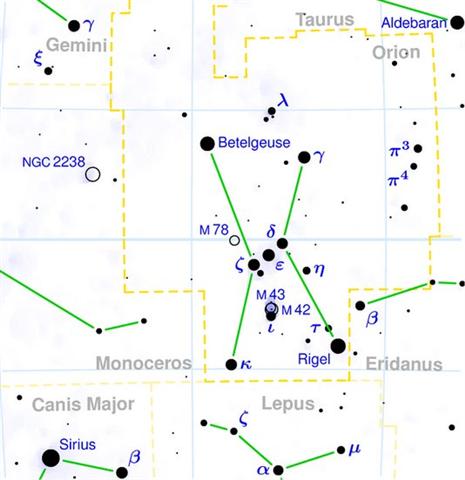 |
|
'May 13 |
14 |
15 |
16 (136 = 163 -
27) |
|
"April 29 |
30 |
"May 1 |
2 (122 = 163 -
41) |
|
APRIL 6 |
7 |
8 |
9 (99 = 163 - 64) |
|
eaha te ariki moe a eve |
ku hukia koia |
ki te rima - o to haú |
e tagata moe |
|
Eve. 1. Placenta, afterbirth
(eeve). T Pau.: eve, womb. Ta.: eve,
placenta. Ma.: ewe, id. Haw.: ewe,
navel string. 2. The rear; taki eeve, the
buttocks; hakahiti ki te eeve, to show the
buttocks; pupuhi eve, syringe. 3. The bottom
of the sea. Churchill. |
 |
 |
 |
 |
 |
|
Bb12-41 |
Bb12-42 |
Bb12-43 (504) |
Bb12-44 |
Bb12-45 |
|
Dec 13 |
14 (348) |
15 |
16 |
17 |
|
OCT 10 |
11 (284) |
12 |
13 |
14 |
|
λ
Arae (267.1),
GIRTAB (Seizer) =
κ
Scorpii,
ο
Serpentis (267.6),
DSIBAN (Wolf Pair) =
ψ
Draconis
(267.9)
|
KELB ALRAI (Dog of the Shepherd) =
β
Ophiuchi,
μ Arae (268.1),
KEW HO (Nine Rivers) =
μ
Herculis
(268.6),
η
Pavonis (268.7),
APOLLYON =
ι
Scorpii
(268.9) |
MULIPHEN (Oaths) =
γ
Ophiuchi
(269.0),
BASANISMUS = G Scorpii
(269.5),
PHERKARD (Dim One of the Two Calves) =
δ
Ursae Minoris
(269.9) |
PTOLEMY CLUSTER = M7 Scorpii
(270.5),
GRUMIUM (Lower Jaw) =
ξ
Draconis
(270.9) |
RUKBALGETHI GENUBI (Bending Claw) =
θ
Herculis
(271.1),
ξ
Herculis (271.5),
ETAMIN (Head) =
γ
Draconis,
ν
Herculis (271.7),
ν
Ophiuchi (271.8) |
 |
|
June 13 (164) |
14 |
15 |
16 |
17 (168) |
|
MENKAURE
Three Stars-21 (Gibbon)
/
Shur-narkabti-sha-shūtū-6
(Star in the Bull towards the south)
/
ANA-IVA-9 (Pillar of exit)
HEAVENLY GATE =
ζ
Tauri,
ν
Columbae (84.0),
ω
Orionis (84.2),
ALNITAK (Girdle) =
ζ
Orionis,
PHAKT (Phaet) =
α
Columbae
(84.7) |
ο Aurigae (85.8), γ Leporis (85.9)
YANG MUN (α Lupi) |
μ Columbae (86.1),
SAIPH (Sword) = κ Orionis
(86.5), τ Aurigae, ζ Leporis (86.6) |
υ Aurigae (87.1), ν Aurigae (87.2),
WEZN (Weight) = β Columbae,
δ Leporis (87.7),
TZE (Son) = λ Columbae
(87.9) |
Ardra-6 (The Moist One)
/
ANA-VARU-8 (Pillar to sit by)
χ¹
Orionis,
ξ
Aurigae (88.1),
BETELGEUZE =
α
Orionis
(88.3),
ξ
Columbae (88.5),
σ
Columbae (88.7)
ZUBEN ELGENUBI (α Librae) |
|
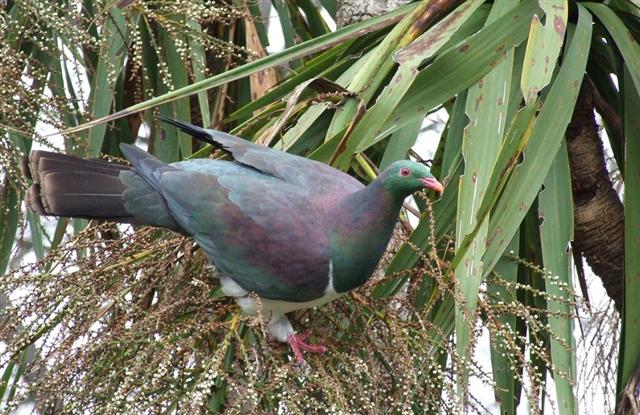
... An oracle reached him from the town of Buto,
which said 'six years only shalt thou live upon this
earth, and in the seventh thou shalt end thy days'.
Mycerinus, indignant, sent an angry message
to the oracle, reproaching the god with his
injustice - 'My father and uncle,' he said 'though
they shut up the temples, took no thought of the
gods and destroyed multitudes of men, nevertheless
enjoyed a long life; I, who am pious, am to die
soon!' There came in reply a second message from the
oracle - 'for this very reason is thy life brought
so quickly to a close - thou hast not done as it
behoved thee ... |
|
'May 17 |
18 |
19 |
20 |
21 (141) |
|
"May 3 |
4 |
5 |
6 |
7 (127) |
|
APRIL 10 |
11 |
12 |
13 |
14 (104) |
|
ki te mauga |
E ariki ra ku ria mauga |
kua rere ia |
ki te mauga |
ko te henua ia kua oti |
|
Riha. Slow, tardy. Mgv.:
ria, id.
Mq.: iá,
id. Ta.: riha,
id. Rihariha:
1. Feeble, cooked too much. 2. Greedy. Mq.:
ihaiha,
gorged, stomach filled to repletion. Churchill.
Oti.
To come to an end; to suffice, to be
enough: ku-oti-á, it is finished; ina kai
oti mo kai, there is not enough to eat;
he-oti á, there isn't anymore left, it's the
last one; it's enough with that. Vanaga. Ta.: 1.
Oti, presage of death. Sa.: oti, to die.
2. To cut. Mq.: koti, oti, id. Sa.:
'oti, id. Ma.: koti, id. Churchill.
 |
"Firuzabad's referred to a Rās
al Tinnin and Dhanab al Tinnin in the heavens, the Dragon's
Head, and Tail; but these have no connection with our Draco,
reference being there made solely to the ascending and
descending nodes in the orbits of the moon and planets known
to Arabian astronomers under these titles.
Primarily, however, these were
from India, and known as Rahu and Kitu. This idea seems to
have originated from the fact that the moon's undulating
course was symbolized by that of the stellar Hydra; and had
the latter word been used instead of 'Dragon', the
expression would now be better understood.
But it was familiar to seamen
as late as the 16th century, for 'the head and tayle of the
Dragon'¹ appears in Eden's Dedication, of 1574, to
Sir Wylliam Wynter; and even now the symbols ... are used
for ... in text-books and almanacs ...
¹ The nodical month also is
called the Dracontic, or Draconitic.
I could not find any
font corresponding to the symbols quoted above for the ascending
and descending nodes. The closest I could find was the last
letter in the Swedish alphabet, viz. Ö, corresponding to the
symbol for the descending node. Ö has 2 dots at the top and
the symbol for the descending node has instead a pair of
small circles.
The symbol for the ascending
node has this pair of small circles below O. A pair of small
circles at bottom, but inside, occur close to
Nodus I in
the G text.

... Milleniums before this,
however, it was of importance on the Nile, as it ceased to
be circumpolar about 5000 BC, and a few centuries thereafter
became the natural successor of Dubhe (α Ursae Majoris),
which up to that date had been the prominent object of
Egyptian temple worship in the north.
γ was known there as Isis,
or Taurt Isis, - the former name applied at one time
to Sirius, - and it marked the head of the Hippopotamus that
was part of our Draco.
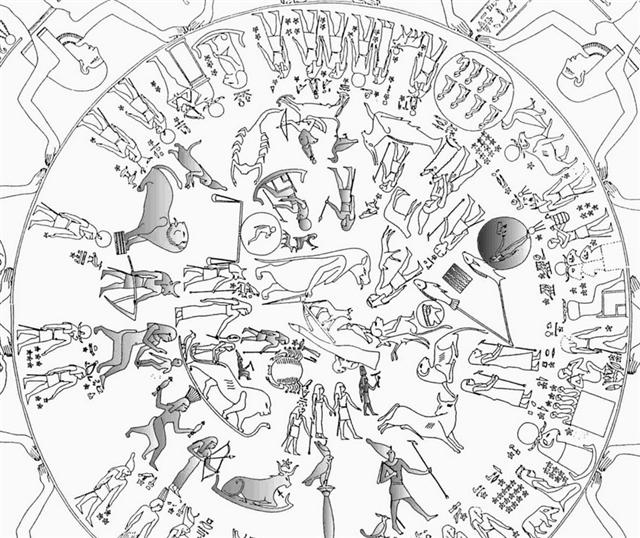
Its rising was visible about
3500 BC through the central passages of the temples of
Hathor at Dendera and of Mut at Thebes; Canopus being seen
through other openings toward the south of the same date.
And Lockyer says that thirteen
centuries later it became the orientation point of the great
Karnak temples of Rameses and Khons at Thebes, the passage
in the former, through which the star was observed, being
1500 feet in length: and that at least seven different
temples were oriented toward it.
When precession had put an end
to this use of the temples, others are thought to have been
built with the same purpose in view; so that there are now
found three different sets of structures close together, and
so oriented that the dates of all, hitherto not certainly
known, may be determinable by this knowledge of the purpose
for which they were designed.
Such being the case, Lockyer
concludes that Hipparchos was not the discoverer of the
precession of the equinoxes, as is generally supposed, but
merely the publisher of that discovery made by the
Egyptians, or perhaps adopted by them from Chaldea.
He also states that Apet,
Bast, Mut, Sekhet, and Taurt
were all titles of one goddess in the Nile worship,
symbolized by γ Draconis.
It is interesting to know that
the Boeotian Thebes, the City of the Dragon, from the story
of its founder Cadmus, shared with its Egyptian namesake the
worhsip of this star in a temple dedicated, as far as its
orientation shows, about 1130 BC: a cult doubtless drawn
from the parent city in Egypt, and adopted elsewhere in
Greece, as also in Italy in the little temple to Isis in
Pompei. Here, however, the city authorities interferred with
this star-worship in one of their numerous raids on the
astrologers, and bricked up the opening whence the star was
observed.
γ lies almost exactly in the
zenith of Greenwich, in fact, has there been called the
Zenith-star; and being circumpolar, descends toward the
horizon, but, without disappearing, rises easterly, and thus
explains the poet's line: the East and the West meet
together. It was nearer the pole
than any other bright star about 4000 years ago ..."
(Allen).

|
































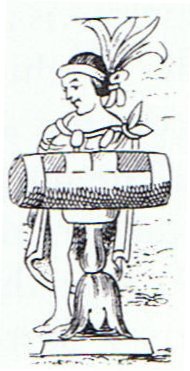











.jpg)




























